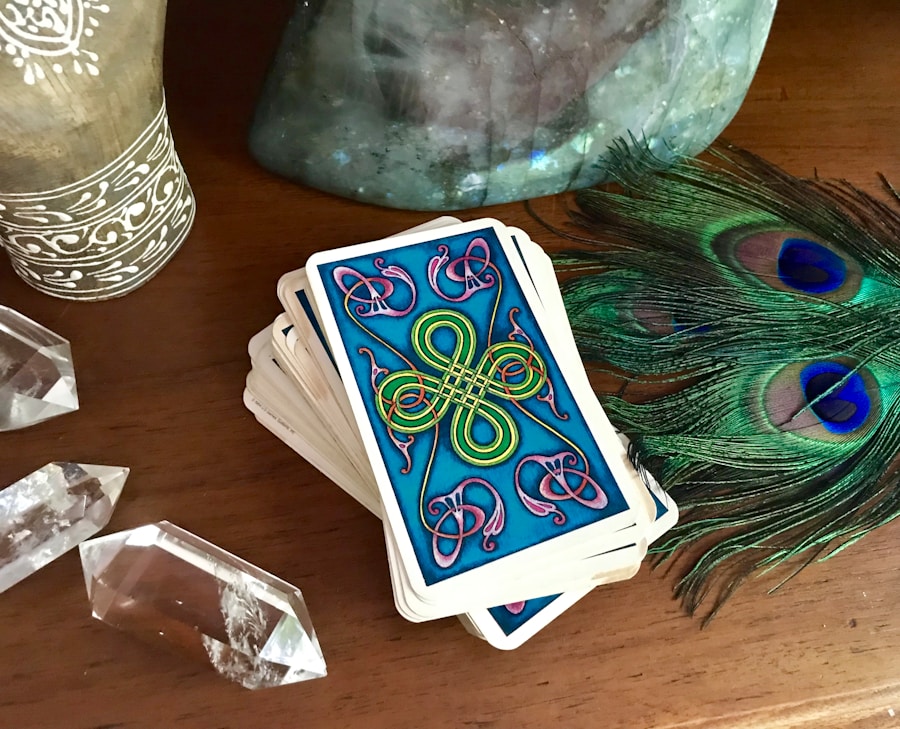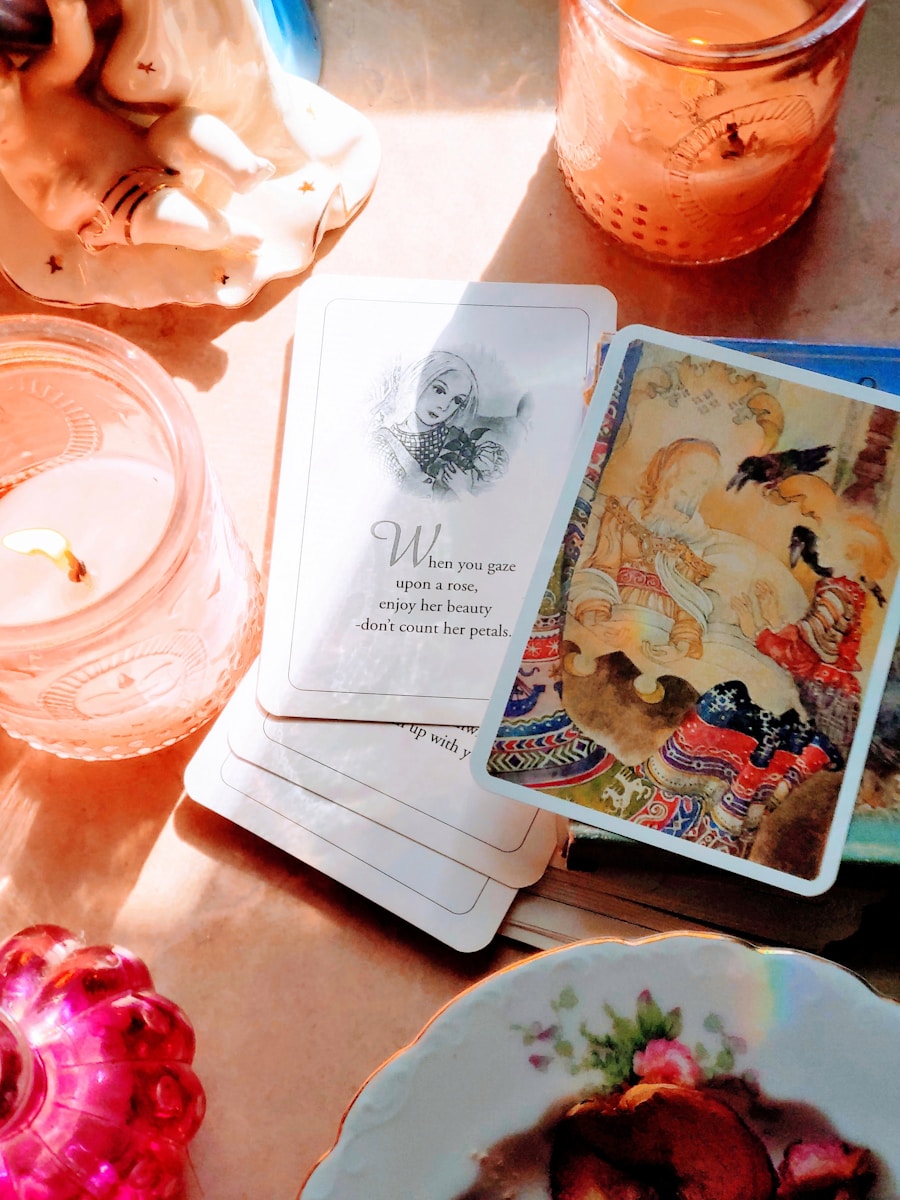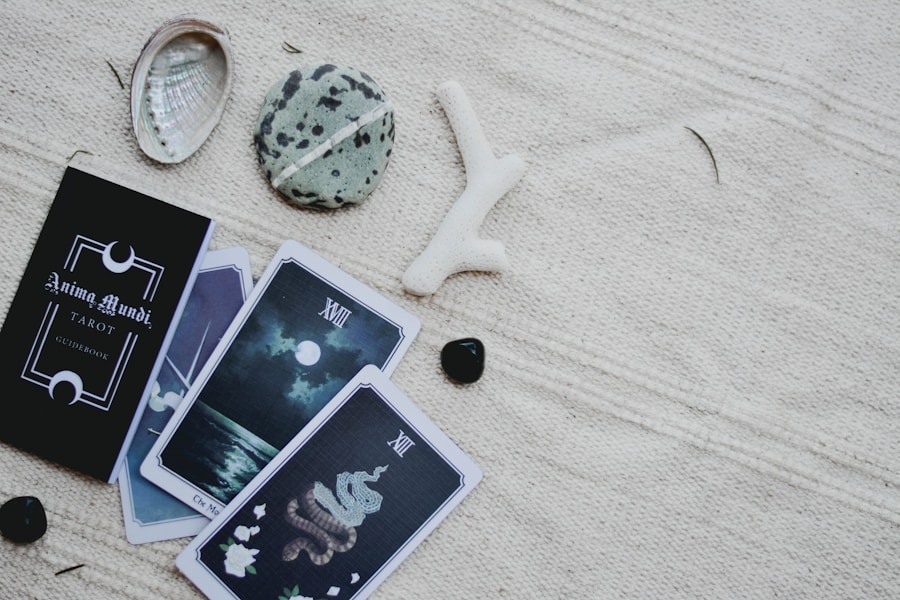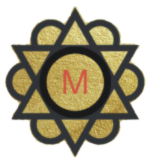
The Death card, often regarded as one of the most misunderstood cards in the Tarot deck, holds a significant place in the realm of divination and self-reflection. Contrary to its ominous name, the Death card does not signify physical demise; rather, it embodies transformation, change, and the cyclical nature of life. In a Tarot reading, this card serves as a powerful reminder that endings are often precursors to new beginnings.
It invites individuals to confront their fears surrounding change and to embrace the opportunities that arise from letting go of the past. The imagery associated with the Death card can evoke strong emotions, but it is essential to approach it with an open mind. The card typically features a skeletal figure, often depicted as the Grim Reaper, riding a horse and carrying a flag adorned with a white rose.
This imagery symbolizes the inevitability of death and the purity of transformation. The presence of various figures in the background—ranging from mourners to those who are reborn—further emphasizes the duality of endings and new beginnings. Understanding the Death card requires delving into its deeper meanings and recognizing its role in personal growth and spiritual evolution.
Key Takeaways
- The Death card in Tarot does not represent physical death, but rather signifies transformation and change.
- The historical and cultural interpretations of the Death card vary widely, from rebirth and renewal to fear and anxiety.
- Symbolism and imagery on the Death card often include a skeleton, a scythe, and a rising sun, representing endings and new beginnings.
- Common misconceptions about the Death card include fear of its literal meaning and misunderstanding its true message of transformation.
- The Death card in Tarot readings can symbolize the end of a phase, letting go of the past, and embracing change and transformation.
Historical and Cultural Interpretations of the Death Card
Historically, the Death card has been interpreted through various lenses across different cultures and time periods. In medieval Europe, Tarot cards were often used for playing games rather than divination. However, as Tarot evolved into a tool for spiritual insight during the Renaissance, the Death card began to take on more profound meanings.
It was during this time that the symbolism of death transitioned from a mere end to a representation of transformation and renewal. The card became associated with the concept of the “Dance of Death,” a medieval allegory that illustrated the universality of death and its role in the human experience. In many cultures, death is not viewed solely as an end but as a transition to another state of being.
For instance, in ancient Egyptian beliefs, death was seen as a passage to the afterlife, where one’s actions in life determined their fate in the next realm. Similarly, in Eastern philosophies such as Buddhism, death is viewed as part of the cycle of samsara—the continuous cycle of birth, death, and rebirth. These cultural interpretations have influenced how the Death card is perceived in modern Tarot readings, emphasizing its role as a harbinger of change rather than an omen of doom.
Symbolism and Imagery of the Death Card

The symbolism embedded within the Death card is rich and multifaceted, offering layers of meaning that can be unpacked through careful analysis. The skeletal figure often represents the inevitability of mortality, serving as a reminder that life is transient and that all things must eventually come to an end. The horse symbolizes movement and progress, suggesting that while death may signify an ending, it also paves the way for new journeys and experiences.
The white rose carried by the figure signifies purity and new beginnings, reinforcing the idea that endings can lead to fresh starts. Additionally, the presence of various figures in the background—such as those mourning or those who appear to be rising from the ground—adds depth to the card’s interpretation. These figures can represent different aspects of human experience: grief, acceptance, and rebirth.
The juxtaposition of life and death within this imagery serves to remind us that transformation is often accompanied by loss but also by renewal. This duality is central to understanding the Death card’s message; it encourages individuals to embrace change rather than fear it.
Common Misconceptions about the Death Card
One of the most prevalent misconceptions surrounding the Death card is its association with literal death or tragedy. Many people instinctively recoil at its appearance in a reading, fearing that it portends bad news or an impending loss.
In reality, while the Death card can indicate significant changes or endings in one’s life, it does not predict physical death but rather signifies transformation and transition. Another common misconception is that the Death card represents something negative or undesirable. This perspective overlooks the positive aspects of change that can arise from endings.
For instance, losing a job may initially seem devastating; however, it can also open doors to new opportunities and personal growth. The Death card encourages individuals to view change as a natural part of life’s ebb and flow rather than something to be feared or resisted. By reframing our understanding of this card, we can begin to appreciate its potential for fostering resilience and adaptability.
Interpretations and Meanings of the Death Card in Tarot Readings
When drawn in a Tarot reading, the Death card can manifest in various ways depending on its position within the spread and the context of the question posed by the querent. In general, it signifies a period of significant transformation or transition. This could relate to personal relationships, career paths, or even spiritual growth.
For example, if someone is contemplating a major life decision—such as ending a long-term relationship—the appearance of the Death card may indicate that this choice is necessary for their personal evolution. Moreover, the Death card can also suggest that certain aspects of one’s life are no longer serving them and need to be released. This could involve letting go of outdated beliefs, toxic relationships, or unfulfilling jobs.
In this sense, it acts as a catalyst for self-reflection and encourages individuals to assess what they truly want moving forward. The card’s message is not one of despair but rather an invitation to embrace change as an opportunity for growth and renewal.
How to Embrace the Death Card’s Message in Tarot Readings

Embracing the message of the Death card requires a willingness to confront one’s fears about change and uncertainty. One effective way to do this is through journaling or meditation focused on themes of transformation. By reflecting on areas in life where change is needed or desired, individuals can begin to identify what they may need to let go of in order to make space for new opportunities.
This process can be both cathartic and enlightening, allowing for deeper self-awareness. Additionally, seeking support from trusted friends or mentors during times of transition can provide valuable perspectives and encouragement. Sharing feelings about impending changes can help alleviate fears and foster a sense of community during challenging times.
Engaging with creative outlets—such as art or music—can also serve as a means of processing emotions related to change and loss.
By cultivating an attitude of acceptance towards change, individuals can navigate life’s transitions with grace and resilience.
If you are interested in exploring the mystical world of numerology further, you may want to check out The Power and Influence of Numerology Number 8. This article delves into the significance of the number 8 and how it can impact various aspects of your life. Additionally, if you are curious about the numerology of birthdays and life path numbers, Numerology of Number 3: Birthday Number and Life Path Number provides valuable insights. And for those intrigued by tarot cards, Unveiling the Mysteries: The Meaning and Interpretation of the Moon Tarot Card offers a detailed analysis of this enigmatic card.
FAQs
What is the Death card in Tarot?
The Death card is one of the major arcana cards in a Tarot deck. It is often depicted with a skeleton on a horse, symbolizing the end of a cycle and the beginning of a new one.
What does the Death card really mean in Tarot?
Contrary to its ominous appearance, the Death card in Tarot does not represent physical death. Instead, it symbolizes transformation, change, and the end of a phase in life to make way for new beginnings.
Is the Death card in Tarot always negative?
No, the Death card in Tarot is not always negative. While it can signify the end of something, it also represents the potential for growth, renewal, and positive change.
How should the Death card be interpreted in a Tarot reading?
When the Death card appears in a Tarot reading, it encourages the seeker to embrace change and let go of the past. It may also indicate the need for transformation and the shedding of old habits or beliefs.
Does the Death card in Tarot predict actual physical death?
No, the Death card in Tarot does not predict actual physical death. Its meaning is metaphorical and symbolic, representing the natural cycles of life and the potential for personal growth and transformation.






